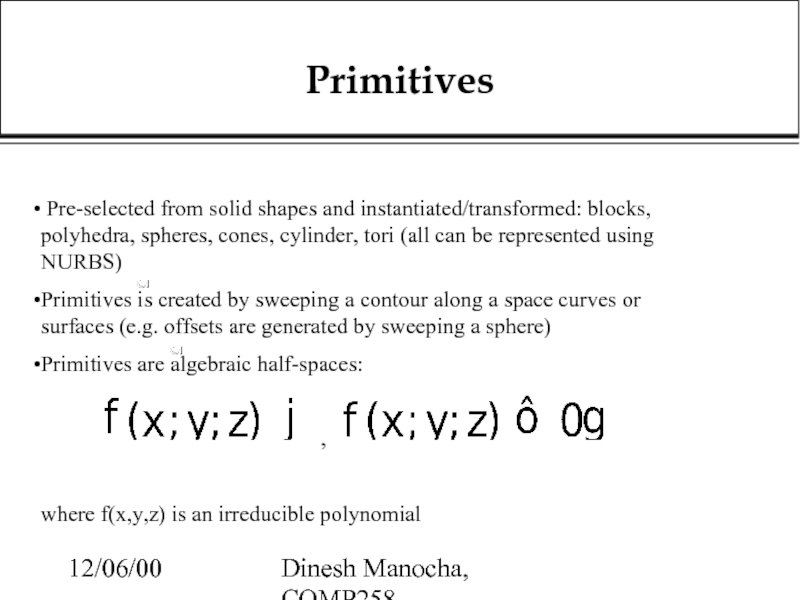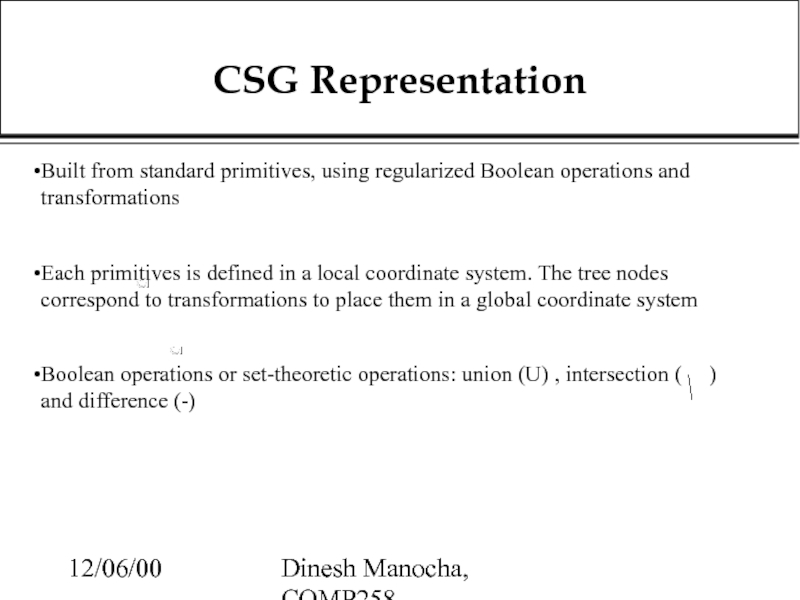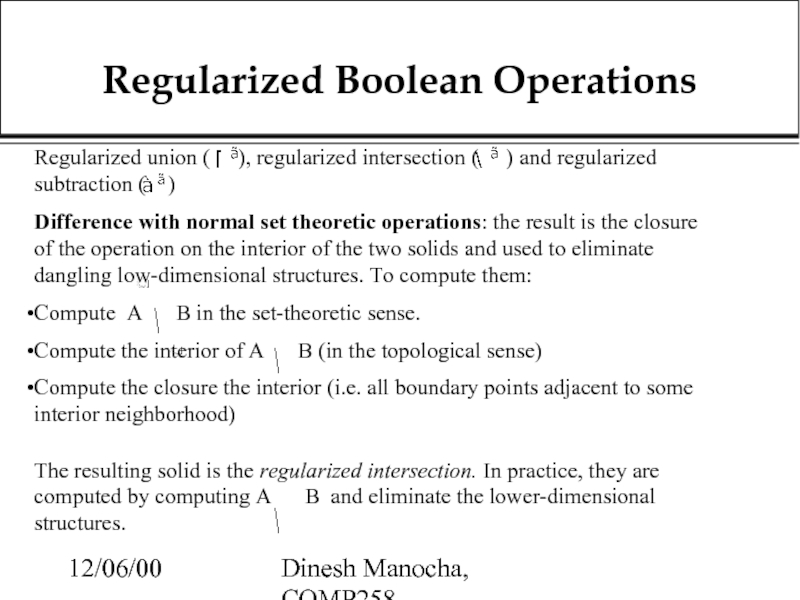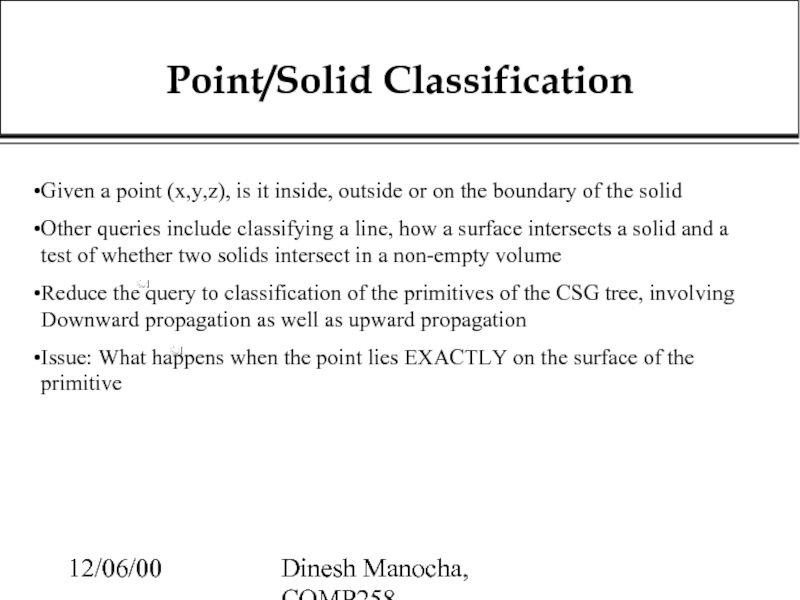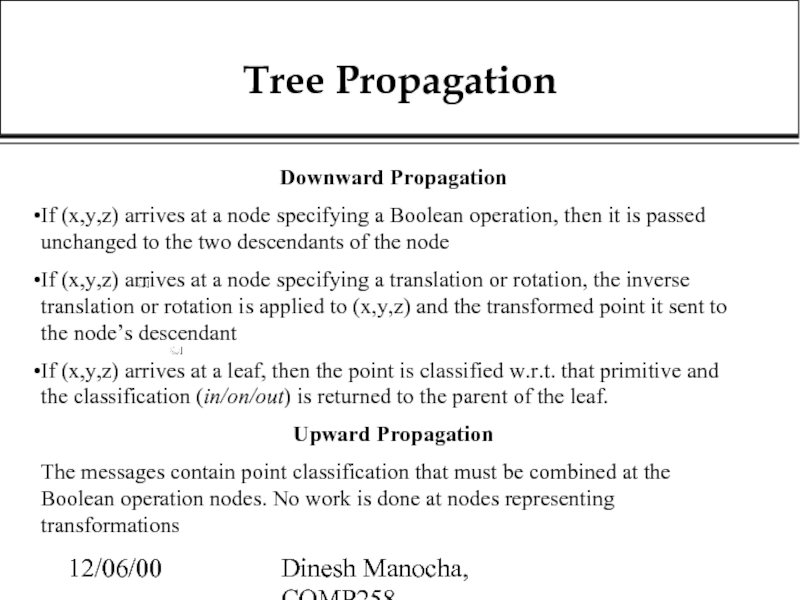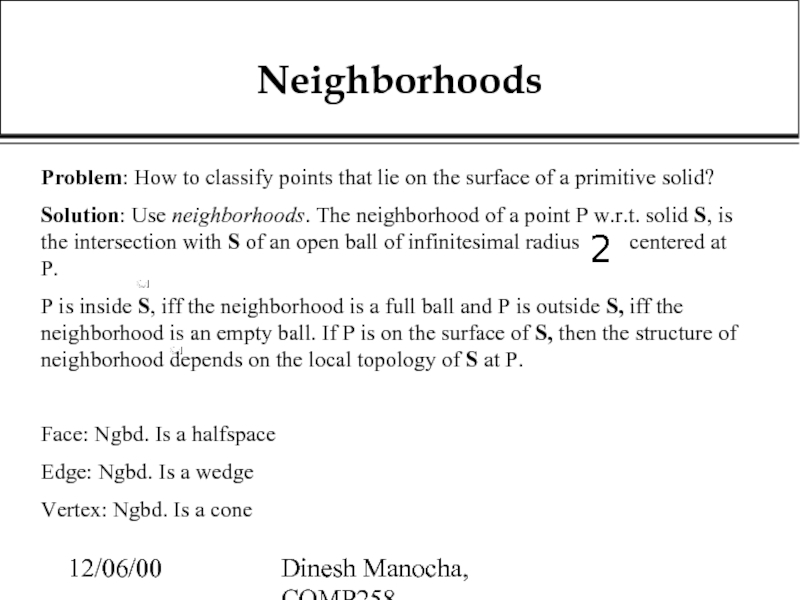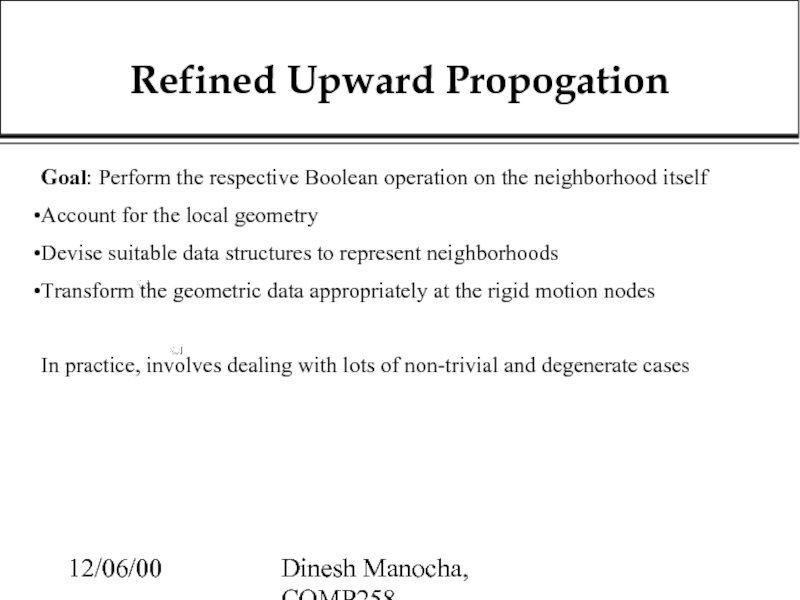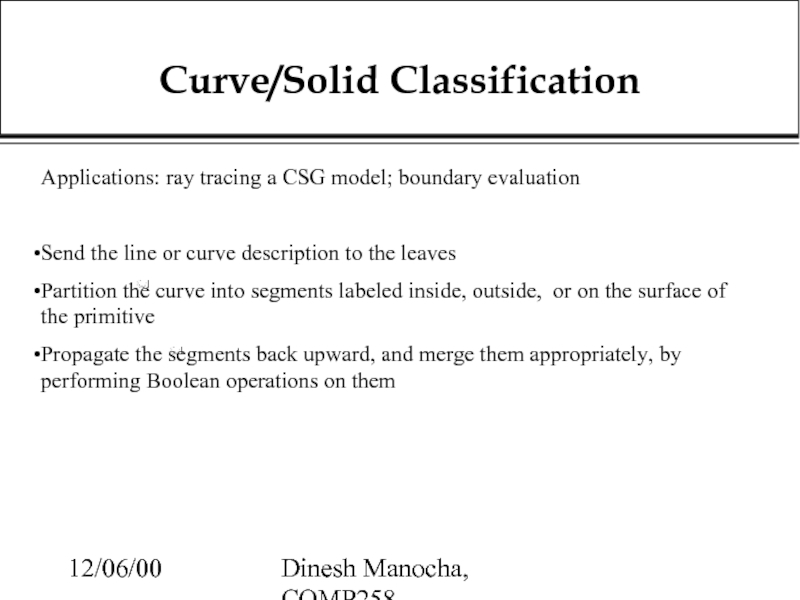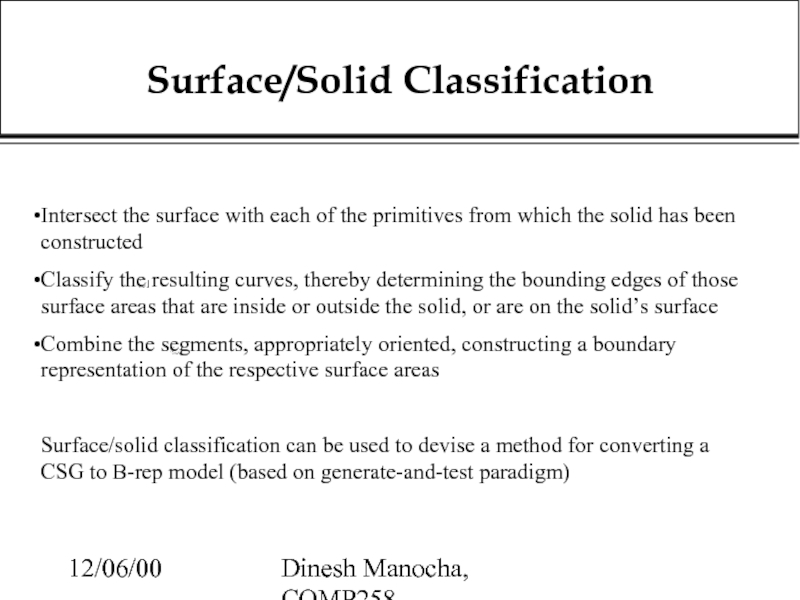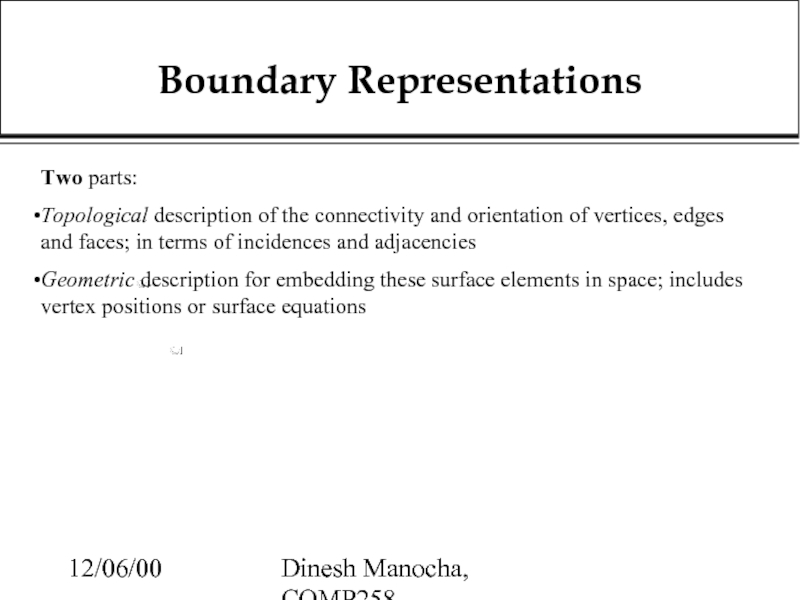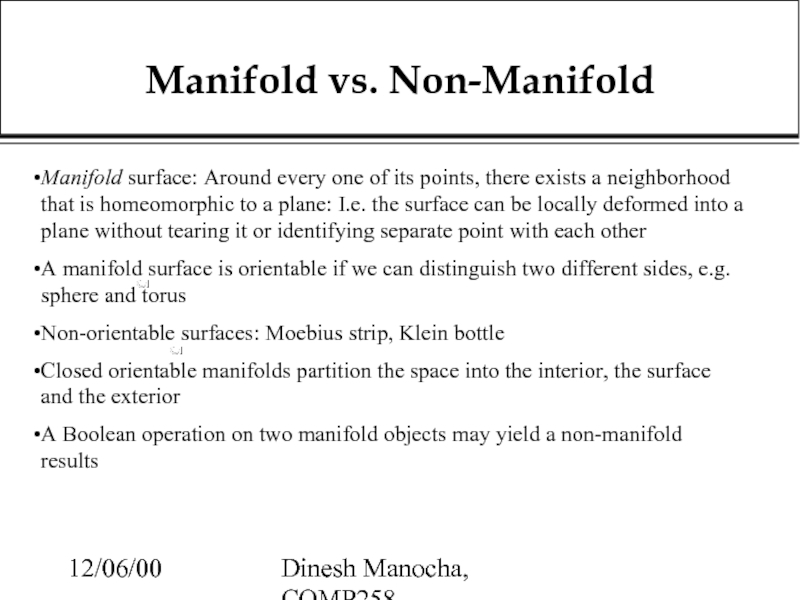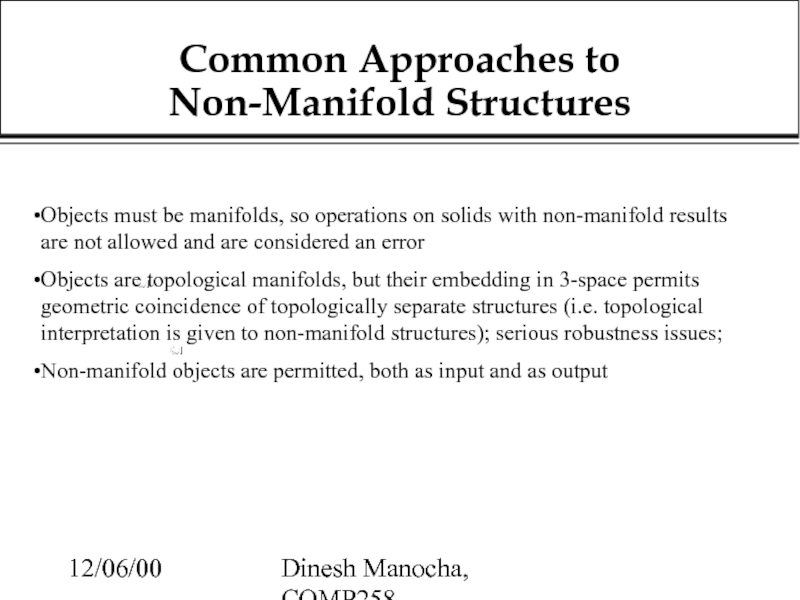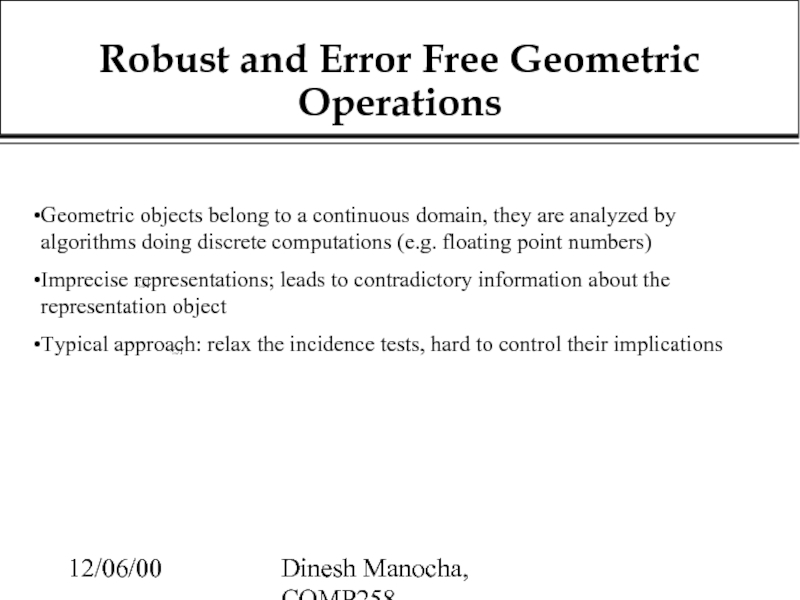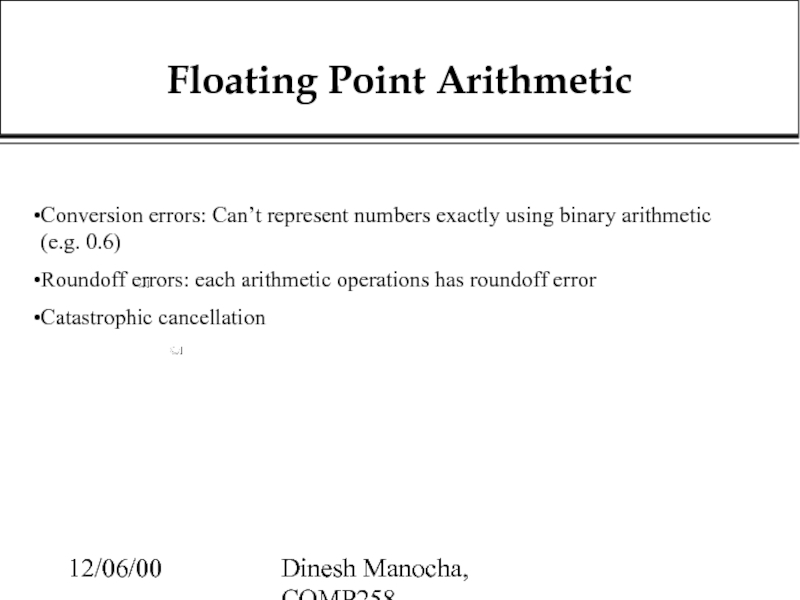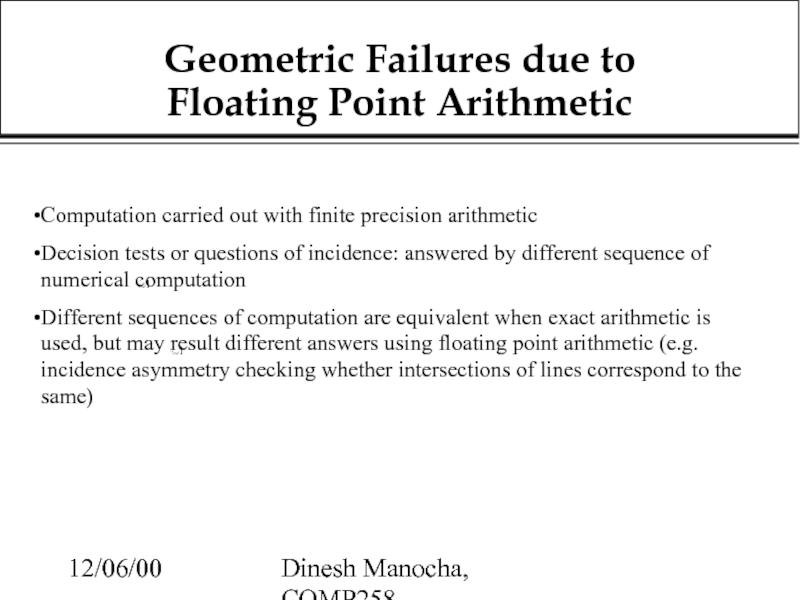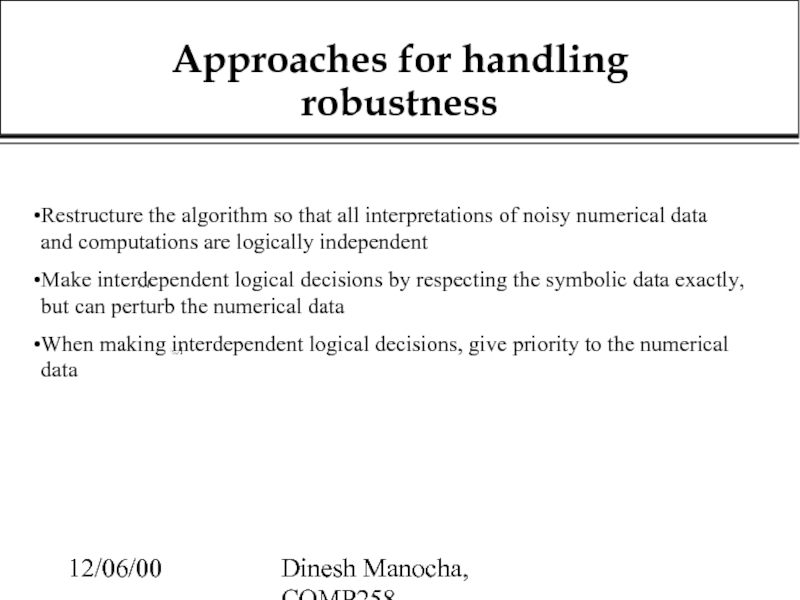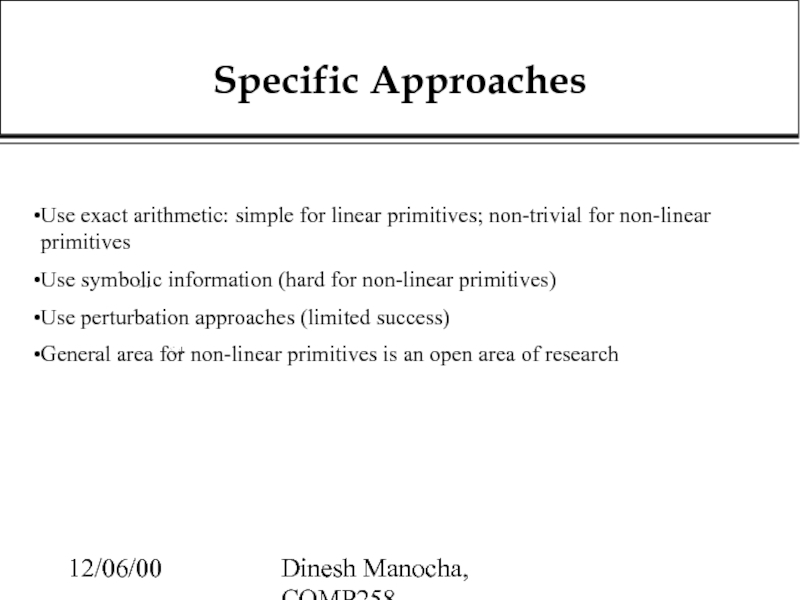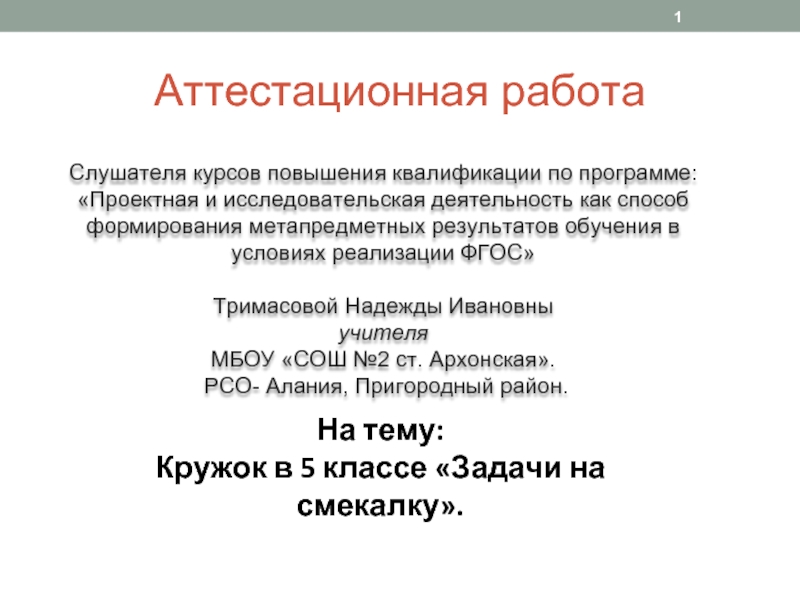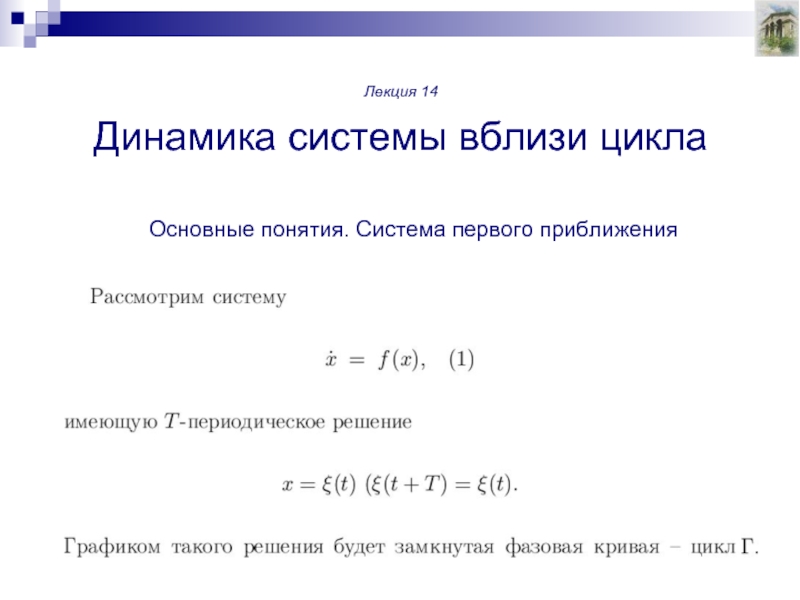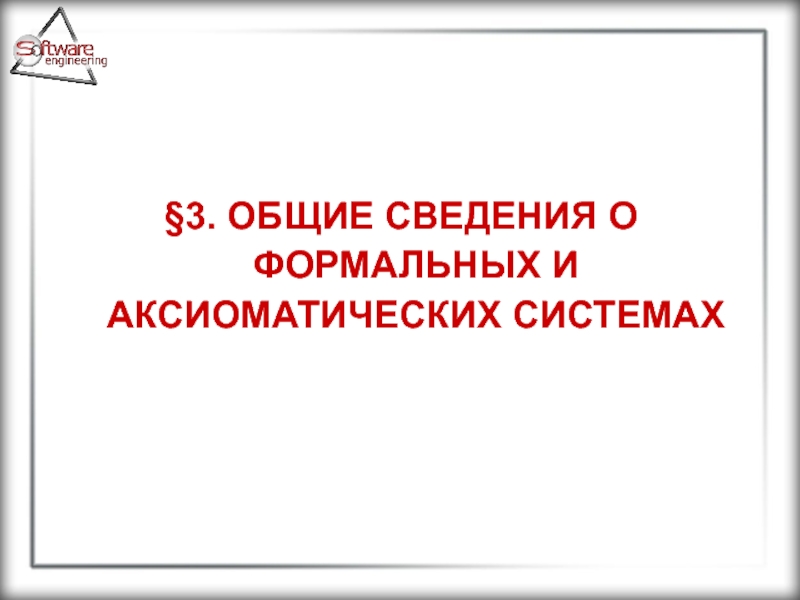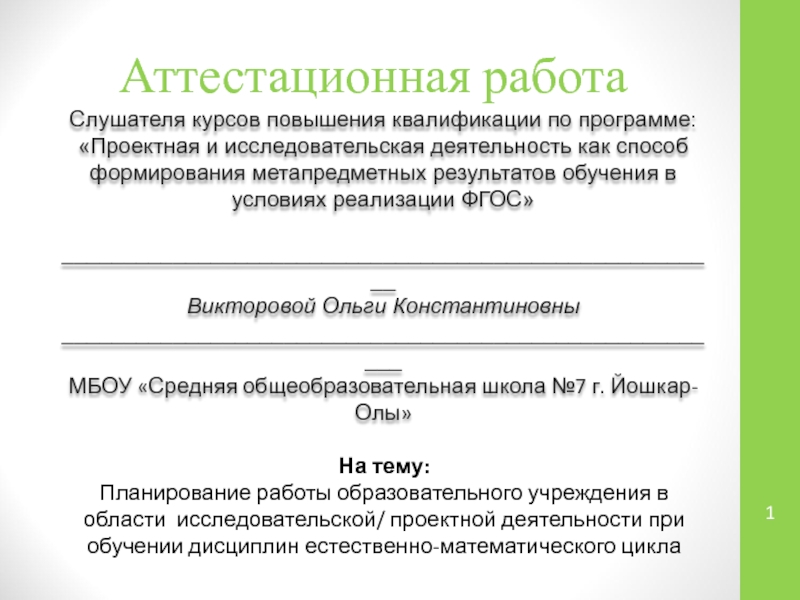Boolean expression of primitive solid objects
Object is always valid (surface is closed, orientable and encloses a volume)
B-Rep (Boundary Representation): Describes the oriented surface of a solid as a data structure composed of vertices, faces and edges
Easier to render
Easier for collision detection, finite element simulation
DUAL REPRESENTATION Modelers: Use both of them
- Главная
- Разное
- Дизайн
- Бизнес и предпринимательство
- Аналитика
- Образование
- Развлечения
- Красота и здоровье
- Финансы
- Государство
- Путешествия
- Спорт
- Недвижимость
- Армия
- Графика
- Культурология
- Еда и кулинария
- Лингвистика
- Английский язык
- Астрономия
- Алгебра
- Биология
- География
- Детские презентации
- Информатика
- История
- Литература
- Маркетинг
- Математика
- Медицина
- Менеджмент
- Музыка
- МХК
- Немецкий язык
- ОБЖ
- Обществознание
- Окружающий мир
- Педагогика
- Русский язык
- Технология
- Физика
- Философия
- Химия
- Шаблоны, картинки для презентаций
- Экология
- Экономика
- Юриспруденция
Solid Modeling презентация
Содержание
- 1. Solid Modeling
- 2. 12/06/00 Dinesh Manocha, COMP258 Primitives
- 3. 12/06/00 Dinesh Manocha, COMP258 CSG Representation
- 4. 12/06/00 Dinesh Manocha, COMP258 Regularized Boolean
- 5. 12/06/00 Dinesh Manocha, COMP258 Point/Solid Classification
- 6. 12/06/00 Dinesh Manocha, COMP258 Tree Propagation
- 7. 12/06/00 Dinesh Manocha, COMP258 Neighborhoods
- 8. 12/06/00 Dinesh Manocha, COMP258 Refined Upward
- 9. 12/06/00 Dinesh Manocha, COMP258 Curve/Solid Classification
- 10. 12/06/00 Dinesh Manocha, COMP258 Surface/Solid Classification
- 11. 12/06/00 Dinesh Manocha, COMP258 Boundary Representations
- 12. 12/06/00 Dinesh Manocha, COMP258 Manifold vs.
- 13. 12/06/00 Dinesh Manocha, COMP258 Common Approaches
- 14. 12/06/00 Dinesh Manocha, COMP258 Robust and
- 15. 12/06/00 Dinesh Manocha, COMP258 Floating Point
- 16. 12/06/00 Dinesh Manocha, COMP258 Geometric Failures
- 17. 12/06/00 Dinesh Manocha, COMP258 Approaches for
- 18. 12/06/00 Dinesh Manocha, COMP258 Specific Approaches
Слайд 112/06/00
Dinesh Manocha, COMP258
Solid Modeling
CSG (Constructive Solid Geometry) Representations: A set theoretic
Слайд 212/06/00
Dinesh Manocha, COMP258
Primitives
Pre-selected from solid shapes and instantiated/transformed: blocks, polyhedra,
spheres, cones, cylinder, tori (all can be represented using NURBS)
Primitives is created by sweeping a contour along a space curves or surfaces (e.g. offsets are generated by sweeping a sphere)
Primitives are algebraic half-spaces:
,
where f(x,y,z) is an irreducible polynomial
Primitives is created by sweeping a contour along a space curves or surfaces (e.g. offsets are generated by sweeping a sphere)
Primitives are algebraic half-spaces:
,
where f(x,y,z) is an irreducible polynomial
Слайд 312/06/00
Dinesh Manocha, COMP258
CSG Representation
Built from standard primitives, using regularized Boolean operations
and transformations
Each primitives is defined in a local coordinate system. The tree nodes correspond to transformations to place them in a global coordinate system
Boolean operations or set-theoretic operations: union (U) , intersection ( ) and difference (-)
Each primitives is defined in a local coordinate system. The tree nodes correspond to transformations to place them in a global coordinate system
Boolean operations or set-theoretic operations: union (U) , intersection ( ) and difference (-)
Слайд 412/06/00
Dinesh Manocha, COMP258
Regularized Boolean Operations
Regularized union ( ), regularized
intersection ( ) and regularized subtraction ( )
Difference with normal set theoretic operations: the result is the closure of the operation on the interior of the two solids and used to eliminate dangling low-dimensional structures. To compute them:
Compute A B in the set-theoretic sense.
Compute the interior of A B (in the topological sense)
Compute the closure the interior (i.e. all boundary points adjacent to some interior neighborhood)
The resulting solid is the regularized intersection. In practice, they are computed by computing A B and eliminate the lower-dimensional structures.
Difference with normal set theoretic operations: the result is the closure of the operation on the interior of the two solids and used to eliminate dangling low-dimensional structures. To compute them:
Compute A B in the set-theoretic sense.
Compute the interior of A B (in the topological sense)
Compute the closure the interior (i.e. all boundary points adjacent to some interior neighborhood)
The resulting solid is the regularized intersection. In practice, they are computed by computing A B and eliminate the lower-dimensional structures.
Слайд 512/06/00
Dinesh Manocha, COMP258
Point/Solid Classification
Given a point (x,y,z), is it
inside, outside or on the boundary of the solid
Other queries include classifying a line, how a surface intersects a solid and a test of whether two solids intersect in a non-empty volume
Reduce the query to classification of the primitives of the CSG tree, involving Downward propagation as well as upward propagation
Issue: What happens when the point lies EXACTLY on the surface of the primitive
Other queries include classifying a line, how a surface intersects a solid and a test of whether two solids intersect in a non-empty volume
Reduce the query to classification of the primitives of the CSG tree, involving Downward propagation as well as upward propagation
Issue: What happens when the point lies EXACTLY on the surface of the primitive
Слайд 612/06/00
Dinesh Manocha, COMP258
Tree Propagation
Downward Propagation
If (x,y,z) arrives at a
node specifying a Boolean operation, then it is passed unchanged to the two descendants of the node
If (x,y,z) arrives at a node specifying a translation or rotation, the inverse translation or rotation is applied to (x,y,z) and the transformed point it sent to the node’s descendant
If (x,y,z) arrives at a leaf, then the point is classified w.r.t. that primitive and the classification (in/on/out) is returned to the parent of the leaf.
Upward Propagation
The messages contain point classification that must be combined at the Boolean operation nodes. No work is done at nodes representing transformations
If (x,y,z) arrives at a node specifying a translation or rotation, the inverse translation or rotation is applied to (x,y,z) and the transformed point it sent to the node’s descendant
If (x,y,z) arrives at a leaf, then the point is classified w.r.t. that primitive and the classification (in/on/out) is returned to the parent of the leaf.
Upward Propagation
The messages contain point classification that must be combined at the Boolean operation nodes. No work is done at nodes representing transformations
Слайд 712/06/00
Dinesh Manocha, COMP258
Neighborhoods
Problem: How to classify points that lie
on the surface of a primitive solid?
Solution: Use neighborhoods. The neighborhood of a point P w.r.t. solid S, is the intersection with S of an open ball of infinitesimal radius centered at P.
P is inside S, iff the neighborhood is a full ball and P is outside S, iff the neighborhood is an empty ball. If P is on the surface of S, then the structure of neighborhood depends on the local topology of S at P.
Face: Ngbd. Is a halfspace
Edge: Ngbd. Is a wedge
Vertex: Ngbd. Is a cone
Solution: Use neighborhoods. The neighborhood of a point P w.r.t. solid S, is the intersection with S of an open ball of infinitesimal radius centered at P.
P is inside S, iff the neighborhood is a full ball and P is outside S, iff the neighborhood is an empty ball. If P is on the surface of S, then the structure of neighborhood depends on the local topology of S at P.
Face: Ngbd. Is a halfspace
Edge: Ngbd. Is a wedge
Vertex: Ngbd. Is a cone
Слайд 812/06/00
Dinesh Manocha, COMP258
Refined Upward Propogation
Goal: Perform the respective Boolean
operation on the neighborhood itself
Account for the local geometry
Devise suitable data structures to represent neighborhoods
Transform the geometric data appropriately at the rigid motion nodes
In practice, involves dealing with lots of non-trivial and degenerate cases
Account for the local geometry
Devise suitable data structures to represent neighborhoods
Transform the geometric data appropriately at the rigid motion nodes
In practice, involves dealing with lots of non-trivial and degenerate cases
Слайд 912/06/00
Dinesh Manocha, COMP258
Curve/Solid Classification
Applications: ray tracing a CSG model;
boundary evaluation
Send the line or curve description to the leaves
Partition the curve into segments labeled inside, outside, or on the surface of the primitive
Propagate the segments back upward, and merge them appropriately, by performing Boolean operations on them
Send the line or curve description to the leaves
Partition the curve into segments labeled inside, outside, or on the surface of the primitive
Propagate the segments back upward, and merge them appropriately, by performing Boolean operations on them
Слайд 1012/06/00
Dinesh Manocha, COMP258
Surface/Solid Classification
Intersect the surface with each of
the primitives from which the solid has been constructed
Classify the resulting curves, thereby determining the bounding edges of those surface areas that are inside or outside the solid, or are on the solid’s surface
Combine the segments, appropriately oriented, constructing a boundary representation of the respective surface areas
Surface/solid classification can be used to devise a method for converting a CSG to B-rep model (based on generate-and-test paradigm)
Classify the resulting curves, thereby determining the bounding edges of those surface areas that are inside or outside the solid, or are on the solid’s surface
Combine the segments, appropriately oriented, constructing a boundary representation of the respective surface areas
Surface/solid classification can be used to devise a method for converting a CSG to B-rep model (based on generate-and-test paradigm)
Слайд 1112/06/00
Dinesh Manocha, COMP258
Boundary Representations
Two parts:
Topological description of the connectivity
and orientation of vertices, edges and faces; in terms of incidences and adjacencies
Geometric description for embedding these surface elements in space; includes vertex positions or surface equations
Geometric description for embedding these surface elements in space; includes vertex positions or surface equations
Слайд 1212/06/00
Dinesh Manocha, COMP258
Manifold vs. Non-Manifold
Manifold surface: Around every one
of its points, there exists a neighborhood that is homeomorphic to a plane: I.e. the surface can be locally deformed into a plane without tearing it or identifying separate point with each other
A manifold surface is orientable if we can distinguish two different sides, e.g. sphere and torus
Non-orientable surfaces: Moebius strip, Klein bottle
Closed orientable manifolds partition the space into the interior, the surface and the exterior
A Boolean operation on two manifold objects may yield a non-manifold results
A manifold surface is orientable if we can distinguish two different sides, e.g. sphere and torus
Non-orientable surfaces: Moebius strip, Klein bottle
Closed orientable manifolds partition the space into the interior, the surface and the exterior
A Boolean operation on two manifold objects may yield a non-manifold results
Слайд 1312/06/00
Dinesh Manocha, COMP258
Common Approaches to Non-Manifold Structures
Objects must be
manifolds, so operations on solids with non-manifold results are not allowed and are considered an error
Objects are topological manifolds, but their embedding in 3-space permits geometric coincidence of topologically separate structures (i.e. topological interpretation is given to non-manifold structures); serious robustness issues;
Non-manifold objects are permitted, both as input and as output
Objects are topological manifolds, but their embedding in 3-space permits geometric coincidence of topologically separate structures (i.e. topological interpretation is given to non-manifold structures); serious robustness issues;
Non-manifold objects are permitted, both as input and as output
Слайд 1412/06/00
Dinesh Manocha, COMP258
Robust and Error Free Geometric Operations
Geometric objects
belong to a continuous domain, they are analyzed by algorithms doing discrete computations (e.g. floating point numbers)
Imprecise representations; leads to contradictory information about the representation object
Typical approach: relax the incidence tests, hard to control their implications
Imprecise representations; leads to contradictory information about the representation object
Typical approach: relax the incidence tests, hard to control their implications
Слайд 1512/06/00
Dinesh Manocha, COMP258
Floating Point Arithmetic
Conversion errors: Can’t represent numbers
exactly using binary arithmetic (e.g. 0.6)
Roundoff errors: each arithmetic operations has roundoff error
Catastrophic cancellation
Roundoff errors: each arithmetic operations has roundoff error
Catastrophic cancellation
Слайд 1612/06/00
Dinesh Manocha, COMP258
Geometric Failures due to Floating Point Arithmetic
Computation
carried out with finite precision arithmetic
Decision tests or questions of incidence: answered by different sequence of numerical computation
Different sequences of computation are equivalent when exact arithmetic is used, but may result different answers using floating point arithmetic (e.g. incidence asymmetry checking whether intersections of lines correspond to the same)
Decision tests or questions of incidence: answered by different sequence of numerical computation
Different sequences of computation are equivalent when exact arithmetic is used, but may result different answers using floating point arithmetic (e.g. incidence asymmetry checking whether intersections of lines correspond to the same)
Слайд 1712/06/00
Dinesh Manocha, COMP258
Approaches for handling robustness
Restructure the algorithm so
that all interpretations of noisy numerical data and computations are logically independent
Make interdependent logical decisions by respecting the symbolic data exactly, but can perturb the numerical data
When making interdependent logical decisions, give priority to the numerical data
Make interdependent logical decisions by respecting the symbolic data exactly, but can perturb the numerical data
When making interdependent logical decisions, give priority to the numerical data
Слайд 1812/06/00
Dinesh Manocha, COMP258
Specific Approaches
Use exact arithmetic: simple for linear
primitives; non-trivial for non-linear primitives
Use symbolic information (hard for non-linear primitives)
Use perturbation approaches (limited success)
General area for non-linear primitives is an open area of research
Use symbolic information (hard for non-linear primitives)
Use perturbation approaches (limited success)
General area for non-linear primitives is an open area of research

